Overview
Waterproof cooling fans present a critical solution for electronics engineers, addressing the pressing issue of moisture damage that can compromise device integrity. These fans not only offer protection against environmental challenges but also significantly enhance durability and cooling efficiency. By employing advanced technologies, they prevent overheating and resist corrosion, which is essential for maintaining the reliability and performance of electronic devices in demanding conditions. Ultimately, the integration of waterproof cooling fans is vital for extending the lifespan of crucial components, ensuring that engineers can deliver robust and dependable solutions in their designs.
Introduction
Waterproof cooling fans are fundamentally transforming the approach electronics engineers take to thermal management, providing a robust solution to the persistent challenges posed by moisture and heat. As the demand for reliable temperature regulation in a variety of environments escalates, these groundbreaking devices not only promise enhanced durability but also offer substantial cost savings over time. Yet, the pivotal question remains: how can engineers fully harness the advantages of waterproof cooling fans to optimize performance and prolong the lifespan of their electronic systems?
Gagner-Toomey Associates: Innovative Waterproof Cooling Solutions for Electronics
Gagner-Toomey Associates stands at the forefront of delivering state-of-the-art thermal management solutions, including waterproof cooling fans, tailored specifically for the electronics sector. By harnessing advanced technologies and innovative designs, the company ensures that engineers have access to dependable temperature control solutions capable of enduring severe conditions.
The demand for waterproof temperature regulation technologies is on the rise, with the global liquid refrigeration market projected to reach USD 12.99 billion by 2030, reflecting a compound annual growth rate of 17.1% from 2021 to 2030. This growth is fueled by the increasing necessity for across various applications, including data centers and high-performance computing environments.
The commitment to excellence is evident in Gagner-Toomey’s diverse portfolio of manufacturers, showcasing high-performance waterproof cooling fans that are engineered to meet the stringent demands of modern electronics applications. Successful implementations of these systems have showcased their effectiveness in bolstering reliability and performance, particularly in environments where moisture and dust present significant challenges.
As electronics engineers continue to innovate, the integration of waterproof thermal management technologies will be crucial in ensuring the durability and efficiency of electronic devices, ultimately empowering engineers to push the boundaries of technology.
Protection Against Moisture Damage: How Waterproof Cooling Fans Safeguard Electronics
Waterproof cooling fans are meticulously engineered to resist moisture ingress, providing essential protection for sensitive electronic components against water damage. By utilizing advanced sealing technologies and high-quality materials, these devices effectively prevent corrosion and short circuits—issues that frequently arise in humid environments. Notably, studies indicate that humidity contributes to approximately 20% of electronic equipment failures, underscoring the importance of these protective measures. In outdoor or industrial environments, where moisture exposure is unavoidable, the waterproof cooling fan plays a vital role in maintaining the operational integrity of devices.
For instance, in medical equipment and food processing applications, waterproof devices are essential in situations where hygiene is critical, ensuring adherence to hygiene standards while enabling regular cleaning without risking damage. Additionally, these devices can attain specific IP ratings, such as IPX4 or IPX5, ensuring compliance and dependable performance in various environments. This blend of durability and reliability guarantees that a waterproof cooling fan stays stable even in harsh environments, making it essential for electronics engineers looking to improve the lifespan and functionality of their setups.
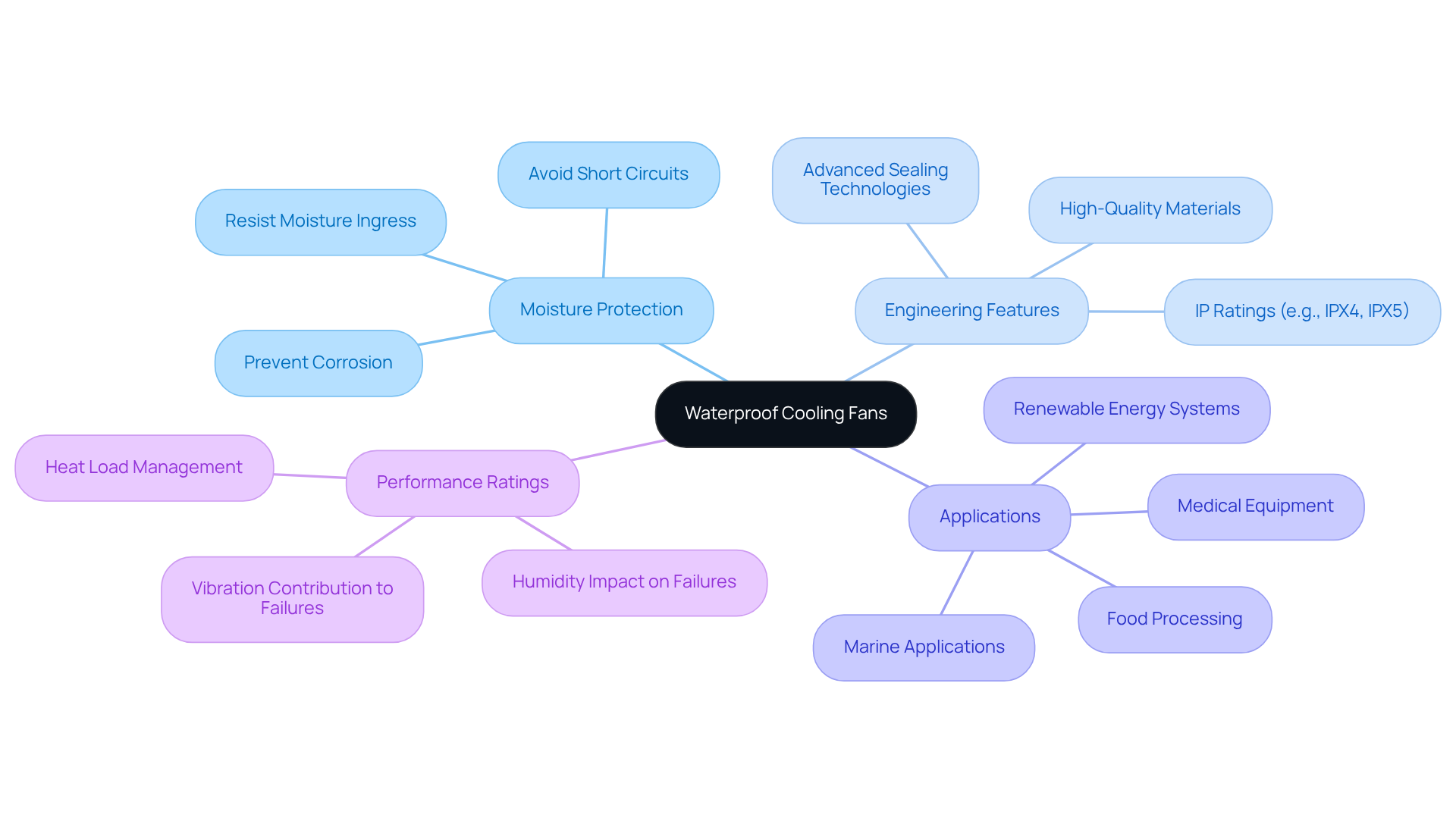
Increased Durability: The Long-Lasting Performance of Waterproof Cooling Fans
Waterproof cooling fans are designed with robust materials and advanced construction techniques that significantly enhance their longevity. Many models are equipped with IP ratings, such as IP67 or IP68, which signify their capacity to endure dust and water exposure, making them ideal for use with a waterproof cooling fan. This exceptional durability results in an , thereby minimizing the frequency of replacements and maintenance. Engineers can rely on these devices to function consistently in challenging environments, ensuring that their systems remain operational without interruption.
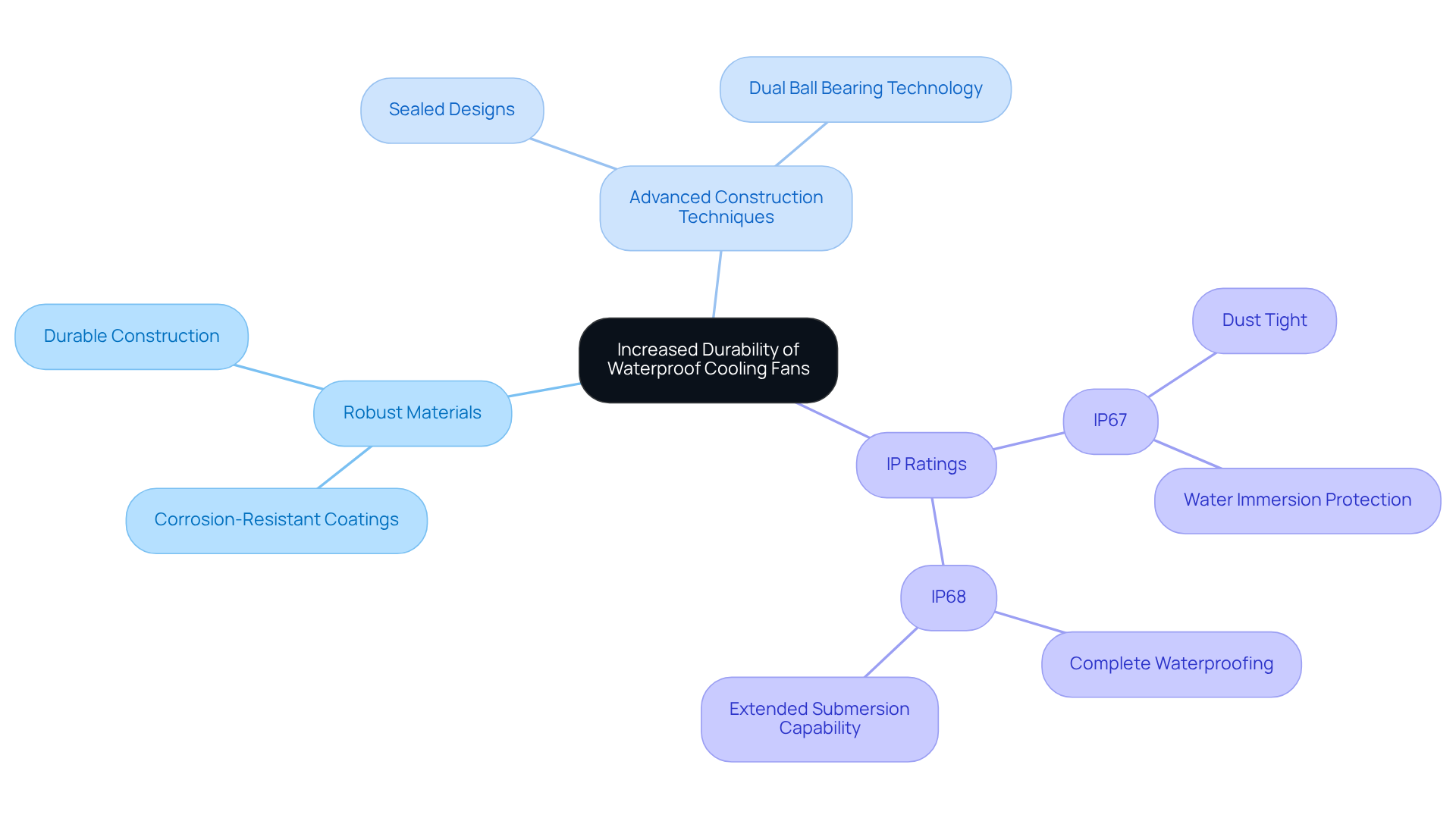
Versatile Applications: Utilizing Waterproof Cooling Fans in Diverse Settings
Waterproof ventilators are indispensable across various applications, including outdoor electronics, automotive equipment, and industrial machinery. Their robust design enables effective operation in wet and dusty environments, rendering them particularly valuable in sectors such as telecommunications, agriculture, and transportation.
In the automotive sector, for instance, waterproof devices are critical for cooling electronic components in vehicles, especially in off-road and high-performance models where exposure to moisture and dust is frequent. Additionally, these devices are vital in medical apparatus, ensuring reliable functionality in environments that require regular cleaning and sterilization.
In renewable energy systems, waterproof blowers play a crucial role in maintaining optimal operating conditions for solar inverters and wind turbines, which are often exposed to outdoor elements. In industrial settings, these devices help sustain ideal operating temperatures for machinery, ensuring reliability and efficiency even in harsh conditions.
The growing market demand for waterproof cooling fans as underscores their versatility, with the industrial temperature control systems market projected to reach USD 42.7 billion by 2035, up from an estimated USD 23.6 billion in 2025, reflecting a CAGR of 6.1%. By integrating waterproof ventilators into their designs, engineers can enhance the reliability of their products, ensuring optimal performance despite environmental challenges.
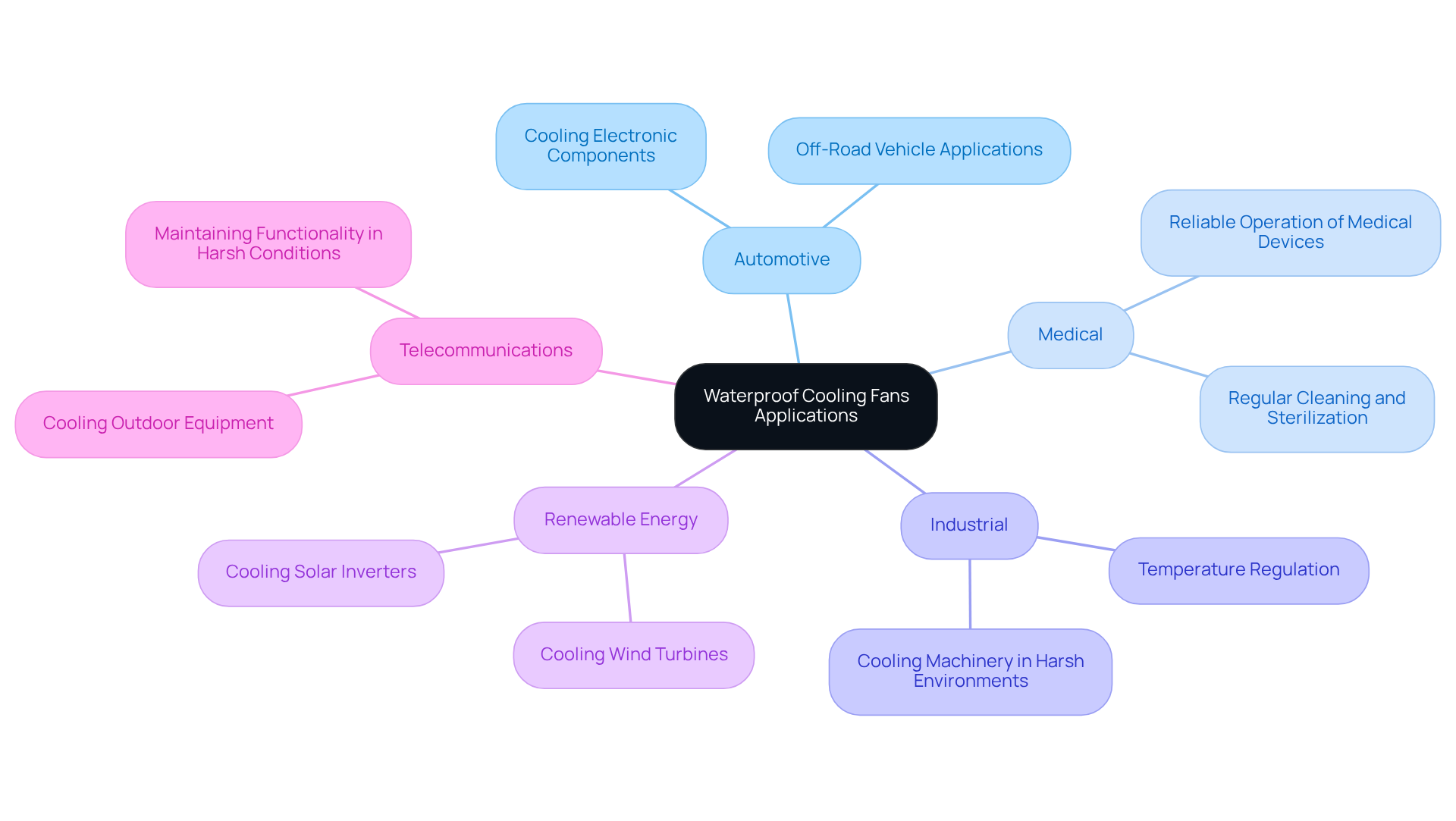
Enhanced Cooling Efficiency: Maintaining Optimal Temperatures with Waterproof Fans
Gagner-Toomey Associates presents waterproof cooling fans designed to deliver effective airflow, ensuring that electronic components remain within their optimal temperature ranges. By efficiently dispersing heat, these devices prevent overheating, which can lead to performance degradation or malfunction.
With cutting-edge blade designs and advanced motor technologies, Gagner-Toomey’s waterproof cooling fan products achieve exceptional , making them a preferred choice for professionals seeking reliable thermal management solutions.
As the world’s largest manufacturer of standard and custom air-movers, Gagner-Toomey offers an extensive array of products, including:
- DC input tube axial devices
- Centrifugal blowers
All optimized for performance, efficiency, and minimal noise. Their comprehensive portfolio also includes integrated temperature control solutions, ensuring that technicians have access to innovative options tailored for diverse applications.
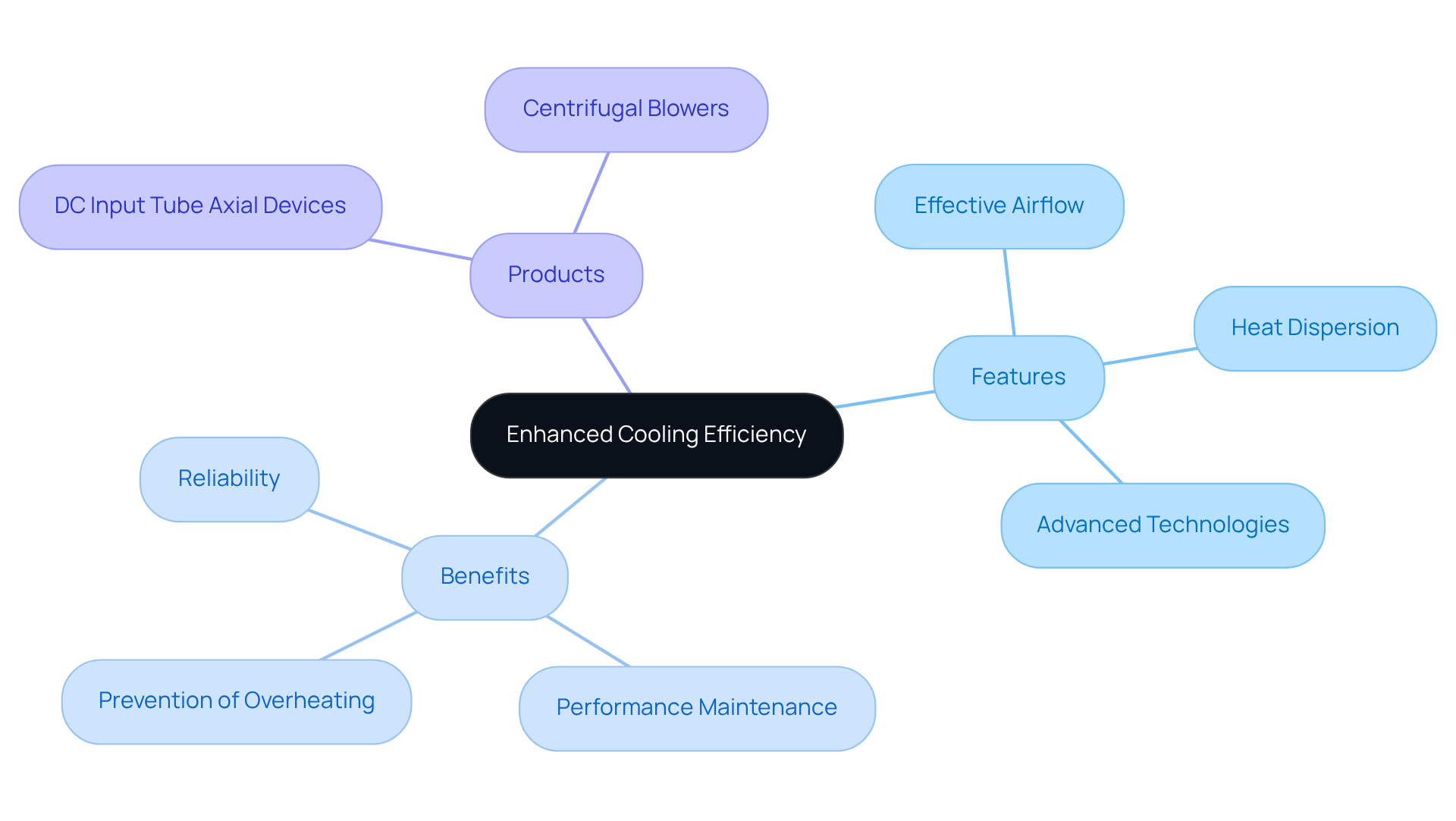
Noise Reduction: Enjoying Quieter Operation with Waterproof Cooling Fans
Increasingly, waterproof cooling fans are designed with noise-reduction technologies, such as optimized blade geometries and advanced motor mechanisms, to significantly lower operational sound levels. This feature is essential in environments where noise can disrupt activities, such as residential spaces and office settings. Engineers have reported that implementing quiet fan solutions can lead to noise reductions of up to 30%, thereby enhancing user comfort and productivity.
As Terry Brice from Red Bull Technology states, “We felt that there had to be a better way to reduce the fan noise other than by compromising the system efficiency and creating additional long term maintenance.” This perspective underscores the importance of innovative approaches in fan design.
Moreover, standard models can achieve noise levels of 40 dB or more, making the selection of quieter options even more critical. By prioritizing a waterproof cooling fan for quiet operation in fan selection, engineers can improve the acoustic environment while maintaining effective temperature control. Understanding is vital for making informed decisions about fan selection, ensuring a more pleasant experience for users while effectively managing thermal requirements.
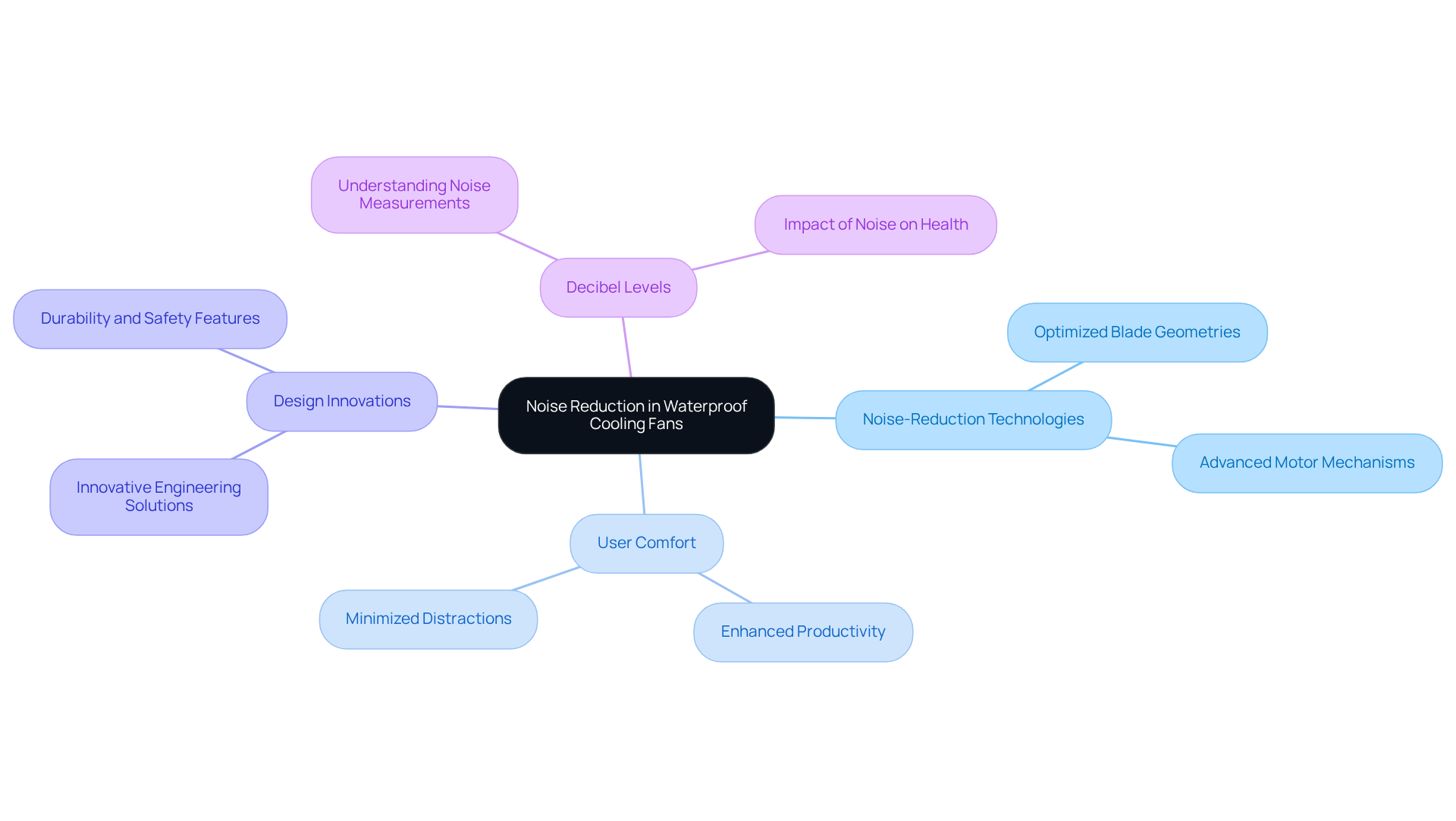
Energy Efficiency: Reducing Power Consumption with Waterproof Cooling Fans
Waterproof cooling fans harness advanced brushless motor technology, markedly enhancing energy efficiency when compared to conventional designs. A BLDC motor operates on just 35 watts, a stark contrast to traditional models that typically consume around 75W. This reduction in energy consumption leads to , particularly in environments where ventilation systems are in constant use, such as data centers and industrial machinery.
For example, utilizing a brushless fan can yield savings of approximately ₹1,168 annually per unit, based on a comparison of yearly costs between a traditional fan (₹1,868.80) and a BLDC fan (₹700.80). Thus, these devices represent an economically prudent choice for long-term applications.
Moreover, the design of brushless motors minimizes mechanical losses and heat generation, which enhances their longevity and reliability. As engineers increasingly emphasize sustainability, as highlighted by Randall Scasny, “the shift towards energy-efficient technologies is not just a trend; it’s a necessity for sustainable development in the electronics industry,” the adoption of waterproof cooling fans not only meets temperature management requirements but also aligns with energy conservation objectives, ultimately reducing the environmental footprint of electronic systems.
It is crucial to recognize that while BLDC units may have higher initial costs compared to conventional models, their long-term benefits substantiate the investment.
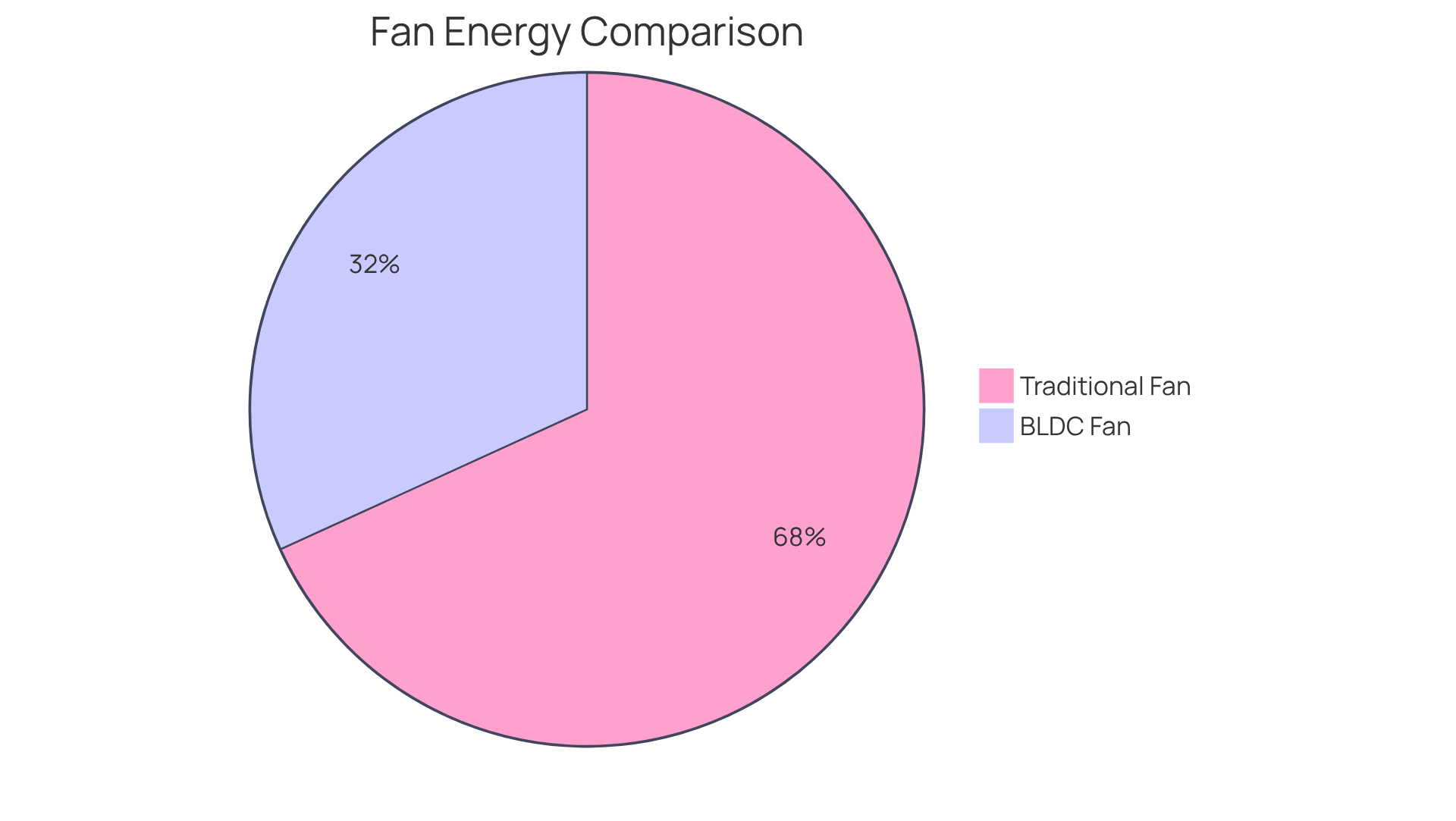
Easy Installation and Maintenance: Simplifying Use with Waterproof Cooling Fans
Waterproof cooling fans address a critical need for , designed with user-friendly characteristics that simplify installation and maintenance. Numerous models offer uniform mounting options and come with clear guidelines, empowering professionals to integrate them seamlessly into their setups. Their robust design significantly reduces the frequency of required maintenance compared to conventional models, which often demand more regular attention due to wear and tear.
For instance, devices equipped with dual ball bearings can last up to 50,000 hours, minimizing downtime and allowing technicians to concentrate on other essential project components without the persistent concern of system reliability. Furthermore, consistent maintenance practices, such as simple wiping with a damp cloth and avoiding harsh chemicals, can extend the longevity of these devices, ensuring they maintain efficiency across various environments.
This combination of durability and ease of maintenance positions waterproof cooling fans as an optimal choice for professionals seeking dependable and effective temperature control solutions.
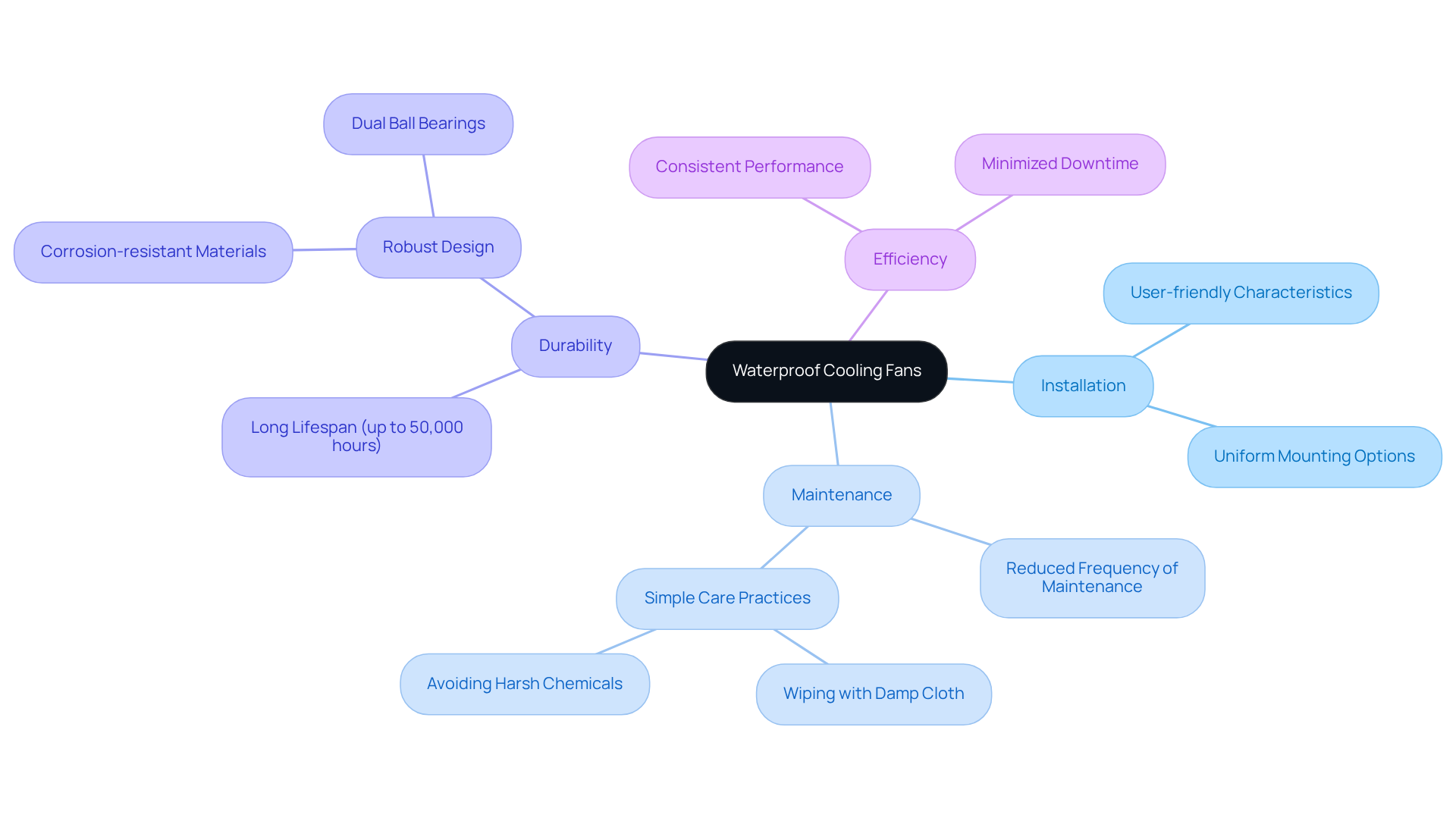
Cost-Effectiveness: Maximizing Value with Waterproof Cooling Fans
Investing in waterproof cooling fans presents a compelling opportunity for electronics engineers, offering substantial long-term savings. These devices are , significantly reducing the need for replacements and minimizing maintenance costs. Their energy-efficient operation translates to lower electricity bills, further underscoring their cost-effectiveness. High-quality waterproof devices can operate efficiently for up to 180,000 hours, boasting an impressive 98% reliability rate, which often exceeds that of conventional ventilation options. This remarkable longevity not only safeguards the investment but also guarantees dependable performance in critical applications, effectively preventing costly downtime.
Moreover, the investment in high-quality fans is crucial for protecting electronic components from overheating, thereby extending their lifespan. By selecting robust temperature control solutions, engineers can optimize their budgets while upholding high standards of performance and reliability. In conclusion, the strategic choice of a waterproof cooling fan not only enhances operational efficiency but also demonstrates an engineer’s commitment to excellence in their field.
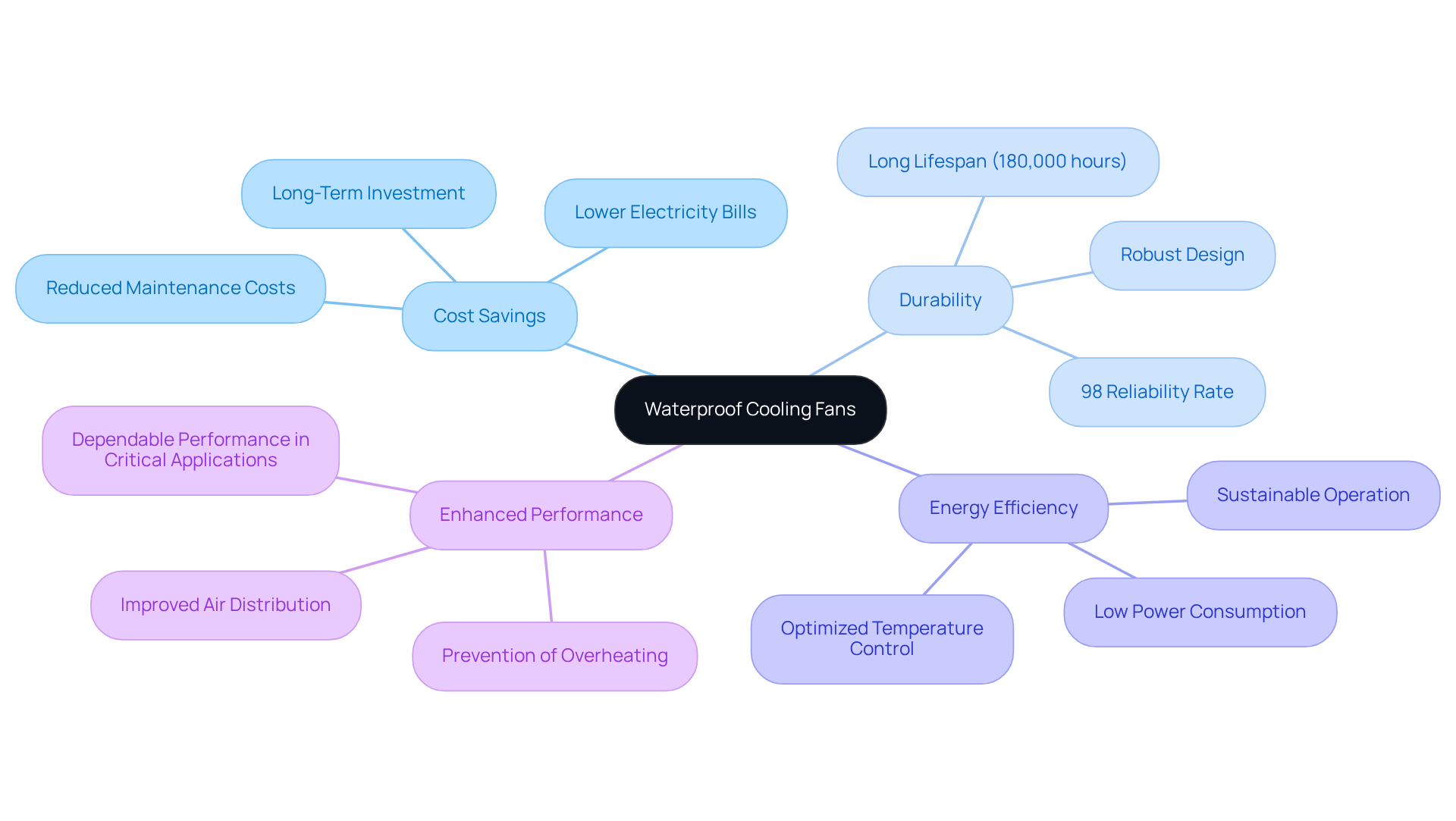
Technological Advancements: Innovations in Waterproof Cooling Fan Design
Recent advancements in waterproof cooling fan design have prominently featured the integration of smart technologies, particularly IoT connectivity and advanced control mechanisms. These innovations facilitate real-time monitoring and adaptive performance adjustments, thereby significantly enhancing the efficiency and reliability of temperature control solutions.
The adoption of IoT in refrigeration units is experiencing rapid growth, with forecasts indicating that the Internet of Things is set to evolve into a multi-trillion dollar sector in the near future. Engineers can leverage these technological advancements to optimize their systems, ensuring they meet the evolving demands of the electronics industry while maintaining stable operating temperatures that contribute to energy efficiency.
Waterproof cooling fans not only prevent overheating but also of sensitive components, making them essential assets in both indoor and outdoor applications.
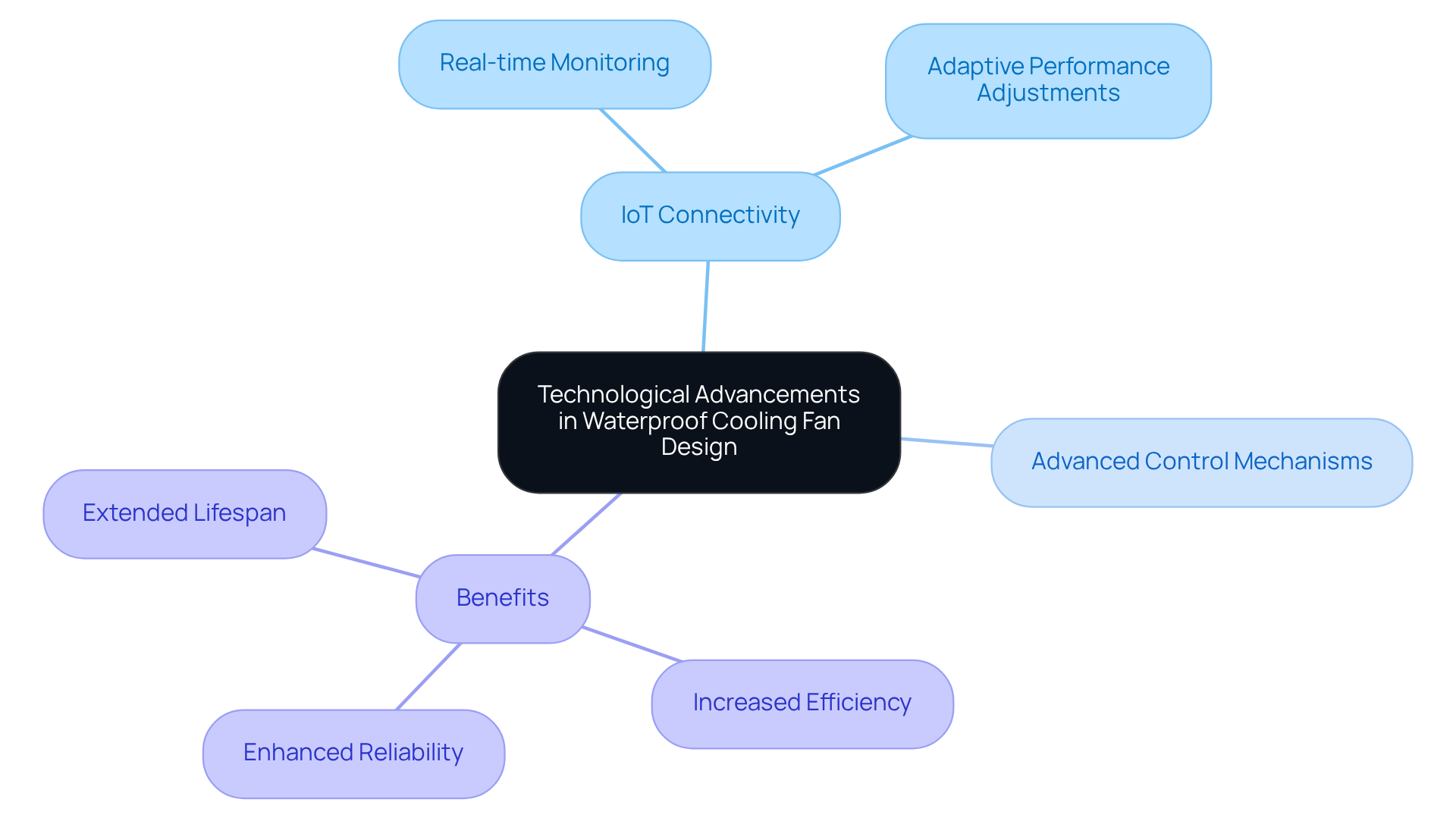
Conclusion
Waterproof cooling fans signify a critical advancement in thermal management solutions for the electronics industry. By integrating these innovative devices, electronics engineers can guarantee optimal performance and reliability in environments susceptible to moisture and dust. The capacity of waterproof fans to shield sensitive components from water damage, coupled with their long-lasting durability, significantly extends the lifespan and functionality of electronic systems.
This article has underscored the key benefits of waterproof cooling fans, including their essential role in:
- Preventing moisture damage
- Enhancing durability
- Providing versatile applications across various sectors
Furthermore, their efficiency in maintaining optimal temperatures, reducing noise levels, and promoting energy savings reinforces their value. The simplicity of installation and maintenance, along with their cost-effectiveness, highlights the strategic advantage of incorporating waterproof cooling fans into electronic designs.
In a rapidly evolving technological landscape, the adoption of waterproof cooling fans is not merely advantageous but imperative for engineers striving to push the boundaries of innovation. As the demand for reliable and efficient thermal management solutions escalates, embracing these advanced cooling technologies will empower engineers to design resilient electronic systems capable of thriving in challenging conditions. Investing in waterproof cooling fans today guarantees a sustainable and high-performance future for electronic applications.
Frequently Asked Questions
What is Gagner-Toomey Associates known for?
Gagner-Toomey Associates is known for delivering innovative thermal management solutions, including waterproof cooling fans, specifically tailored for the electronics sector.
What is the projected growth of the global liquid refrigeration market?
The global liquid refrigeration market is projected to reach USD 12.99 billion by 2030, with a compound annual growth rate of 17.1% from 2021 to 2030.
Why is there an increasing demand for waterproof temperature regulation technologies?
The demand is rising due to the necessity for efficient thermal management in various applications, including data centers and high-performance computing environments.
How do waterproof cooling fans protect electronic components?
Waterproof cooling fans are engineered to resist moisture ingress, preventing corrosion and short circuits that can occur in humid environments.
What percentage of electronic equipment failures is attributed to humidity?
Studies indicate that humidity contributes to approximately 20% of electronic equipment failures.
In what environments are waterproof cooling fans particularly vital?
They are particularly vital in outdoor or industrial environments where moisture exposure is unavoidable, as well as in medical equipment and food processing applications where hygiene is critical.
What are IP ratings, and why are they important for waterproof cooling fans?
IP ratings, such as IPX4 or IPX5, signify the level of protection against moisture and dust. These ratings ensure compliance and dependable performance in various environments.
What materials and construction techniques enhance the durability of waterproof cooling fans?
Waterproof cooling fans are designed with robust materials and advanced construction techniques, which significantly enhance their longevity.
What do IP67 or IP68 ratings indicate about waterproof cooling fans?
IP67 or IP68 ratings indicate that the fans can endure dust and water exposure, making them ideal for challenging environments.
What benefits do engineers gain from using waterproof cooling fans?
Engineers benefit from the extended lifespan and reliability of waterproof cooling fans, minimizing the frequency of replacements and maintenance while ensuring consistent operation in harsh environments.

